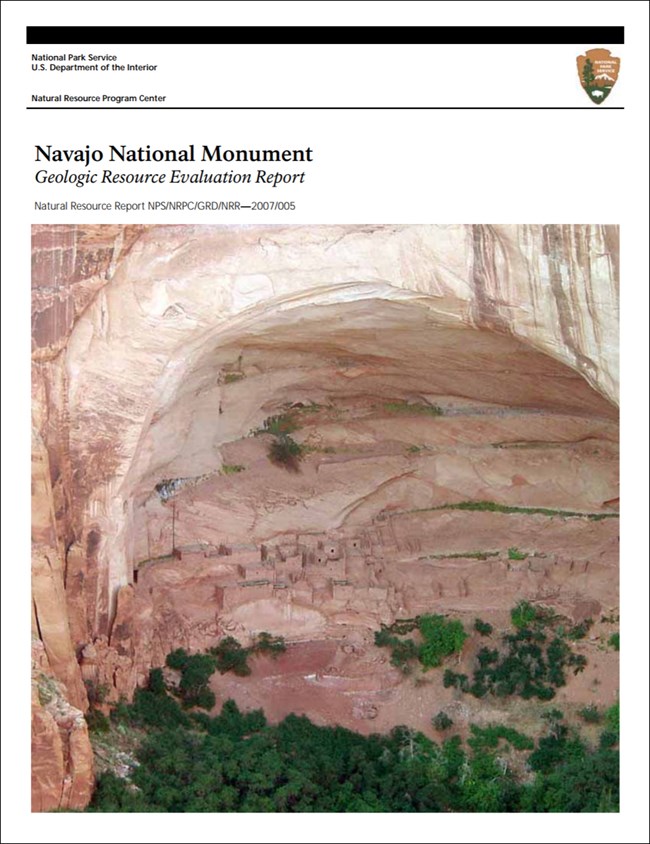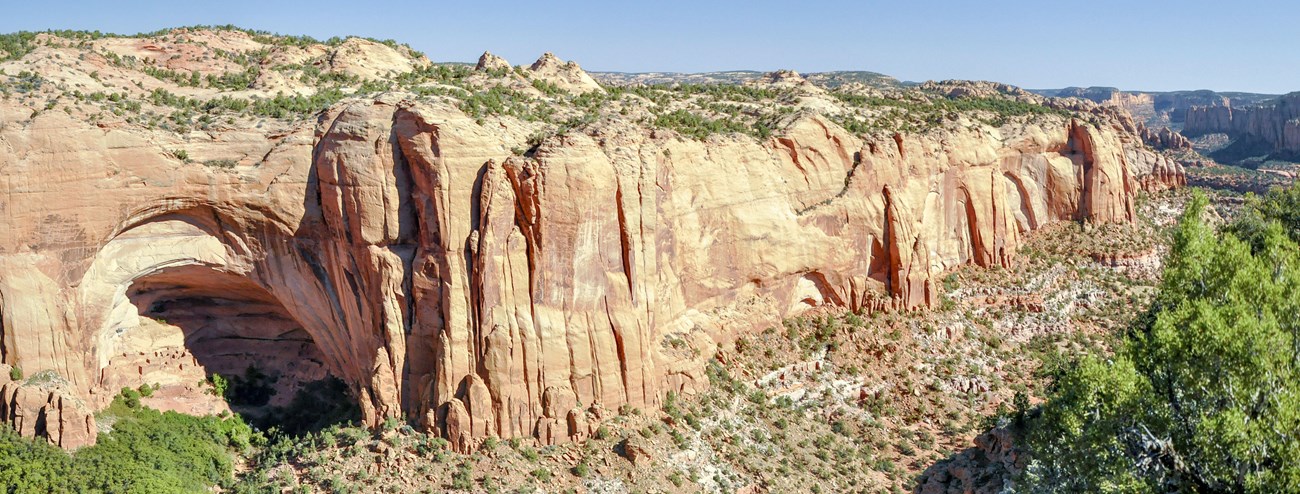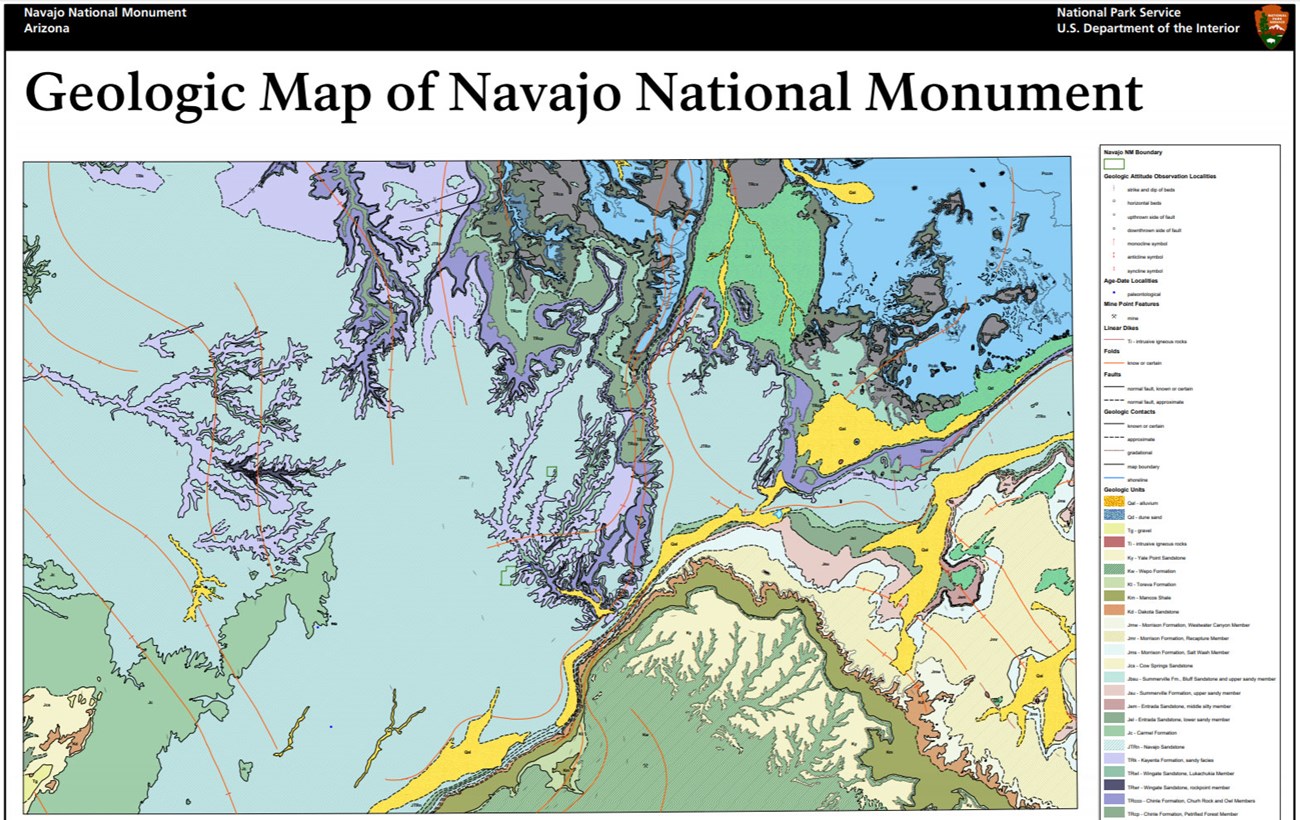Last updated: July 11, 2024
Article
NPS Geodiversity Atlas—Navajo National Monument, Arizona
Geodiversity refers to the full variety of natural geologic (rocks, minerals, sediments, fossils, landforms, and physical processes) and soil resources and processes that occur in the park. A product of the Geologic Resources Inventory, the NPS Geodiversity Atlas delivers information in support of education, Geoconservation, and integrated management of living (biotic) and non-living (abiotic) components of the ecosystem.

Geologic Features and Processes
Alcoves
The primary geologic features of interest at Navajo National Monument are the alcoves that formed due to groundwater flow, dissolution of carbonate cement, gravity, and wind erosion. The Navajo Sandstone is porous and permeable but the underlying Kayenta Formation is not. The Kayenta, therefore, acts as a barrier to vertical groundwater flow. Water infiltrating into the sandstone on the Shonto Plateau moves laterally at the Navajo- Kayenta interface and emerges as springs along the canyon walls.
The carbonate matrix holding the sand grains of the Kayenta Formation together slowly dissolves as a result of ground water flow. Loosened grains destroy the integrity of the rock, undermining the cliffs of Navajo Sandstone lying above. Over time, slabs of the Navajo Sandstone break away into the canyon, eventually forming alcoves. These alcoves, especially ones with a spring at the Navajo/Kayenta interface, were attractive sites for occupation by prehistoric peoples.
A textbook example of alcove formation is found at Betatakin ruins near the visitor center. The ruins occupy an alcove that formed as the Navajo Sandstone, undermined by erosion of the less resistant Kayenta Formation, broke away in arching slabs. The arched ceiling of Betatakin ruins offers a unique acoustic experience, as whispers from one end of the ruins can be easily understood at the other.
Navajo Sandstone
The Navajo Sandstone consists mostly of large- scale cross- bedded, pale salmon- colored, eolian sandstone with minor lenses of pink clay and light gray freshwater limestone that formed in small lakes and ponds during the Jurassic (Peterson 1994). The Navajo Sandstone thickens to the northwest and may reach 1,800 feet (550 m) thick on the Navajo Reservation (Cooley et al. 1969). The Navajo Sandstone is one of the largest preserved eolian systems in the stratigraphic record, and along with its correlatives, the most widespread eolian deposit in North America (Blakey 1994; Peterson 1994). These Lower Jurassic dune sands are distributed from northwestern Wyoming and adjacent Idaho southward to southern Arizona and northern Mexico. Much of the surface of the Navajo Sandstone is barren of vegetation so that the preserved arcs and swirls of eolian cross- bedding in the preserved dunes are fully exposed.
Several sets of vertical joints in the rocks were produced by strains and stresses of deep burial and subsequent uplift. The vertical joints are deeply incised and serve as watercourses for surface flow during rainstorms. Rows of miniature pools mark these watercourses. The pools fill with rainwater and serve as habitats for small plants and animals, many of them microscopic. By- products of these animals and plants include acids that dissolve the limy cement holding the sand grains together. Lichens secrete acids that also loosen grains that are blown away by wind. The barren patches are surrounded by thin soil that is hardly more than wind- blown sand held together by roots of trees, shrubs, and grass.
Desert Varnish
A surface stain of manganese oxide and/or iron oxide known as desert varnish locally forms a brown or black coat on the bare Navajo Sandstone. Ancestral Puebloans used this desert varnish as a backdrop for their petroglyphs. Pictographs were also drawn on the salmon- colored sandstone.
Regional Geology
Navajo National Monument is a part of the Colorado Plateaus Physiographic Province and shares its geologic history and some characteristic geologic formations with a region that extends well beyond park boundaries.
- Scoping summaries are records of scoping meetings where NPS staff and local geologists determined the park’s geologic mapping plan and what content should be included in the report.
- Digital geologic maps include files for viewing in GIS software, a guide to using the data, and a document with ancillary map information. Newer products also include data viewable in Google Earth and online map services.
- Reports use the maps to discuss the park’s setting and significance, notable geologic features and processes, geologic resource management issues, and geologic history.
- Posters are a static view of the GIS data in PDF format. Newer posters include aerial imagery or shaded relief and other park information. They are also included with the reports.
- Projects list basic information about the program and all products available for a park.
Source: NPS DataStore Saved Search 3029. To search for additional information, visit the NPS DataStore.
A NPS Soil Resources Inventory project has been completed for Navajo National Monument and can be found on the NPS Data Store.
Source: NPS DataStore Saved Search 3076. To search for additional information, visit the NPS DataStore.

Related Links
Related Articles
Navajo National MonumentNational Park Service Geodiversity Atlas
The servicewide Geodiversity Atlas provides information on geoheritage and geodiversity resources and values within the National Park System. This information supports science-based geoconservation and interpretation in the NPS, as well as STEM education in schools, museums, and field camps. The NPS Geologic Resources Division and many parks work with National and International geoconservation communities to ensure that NPS abiotic resources are managed using the highest standards and best practices available.

